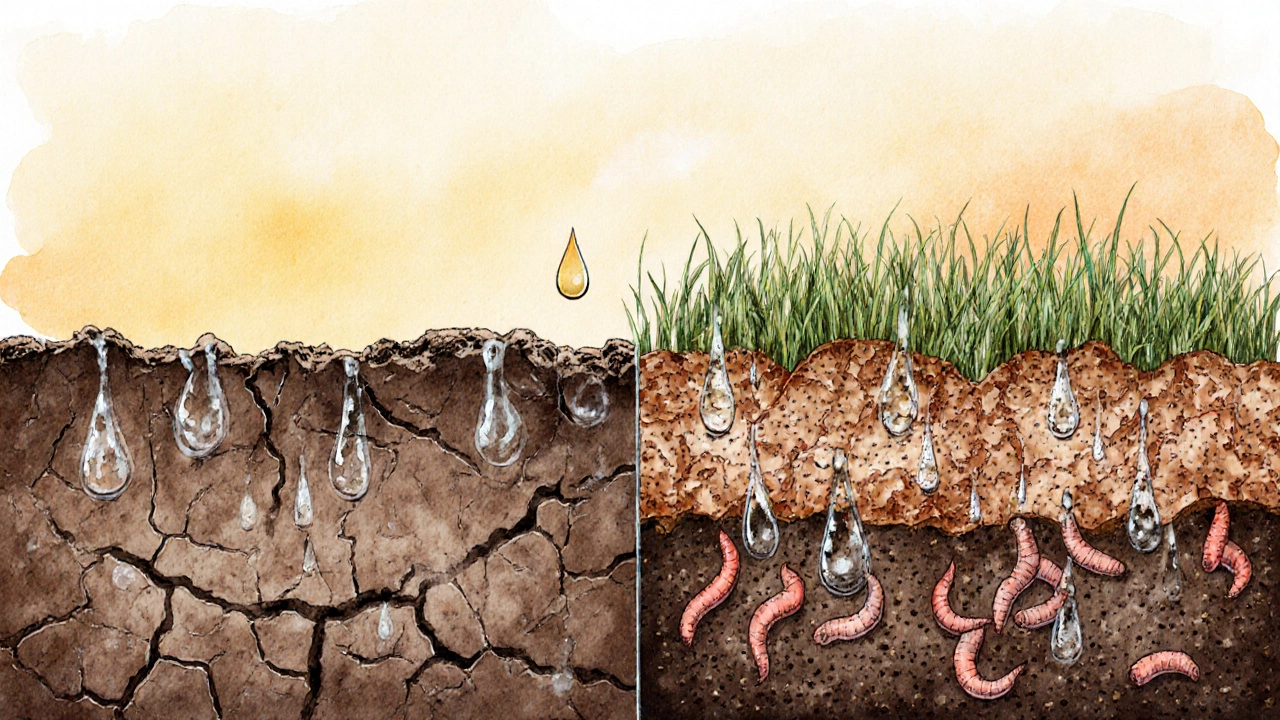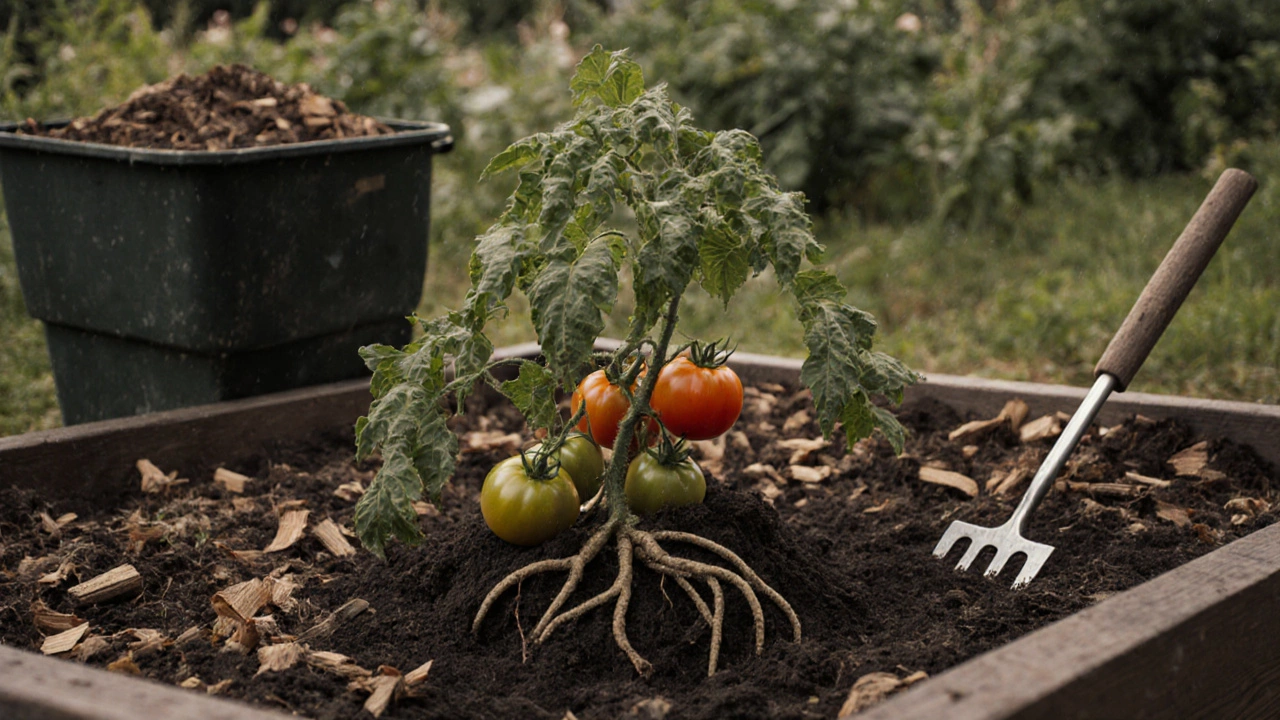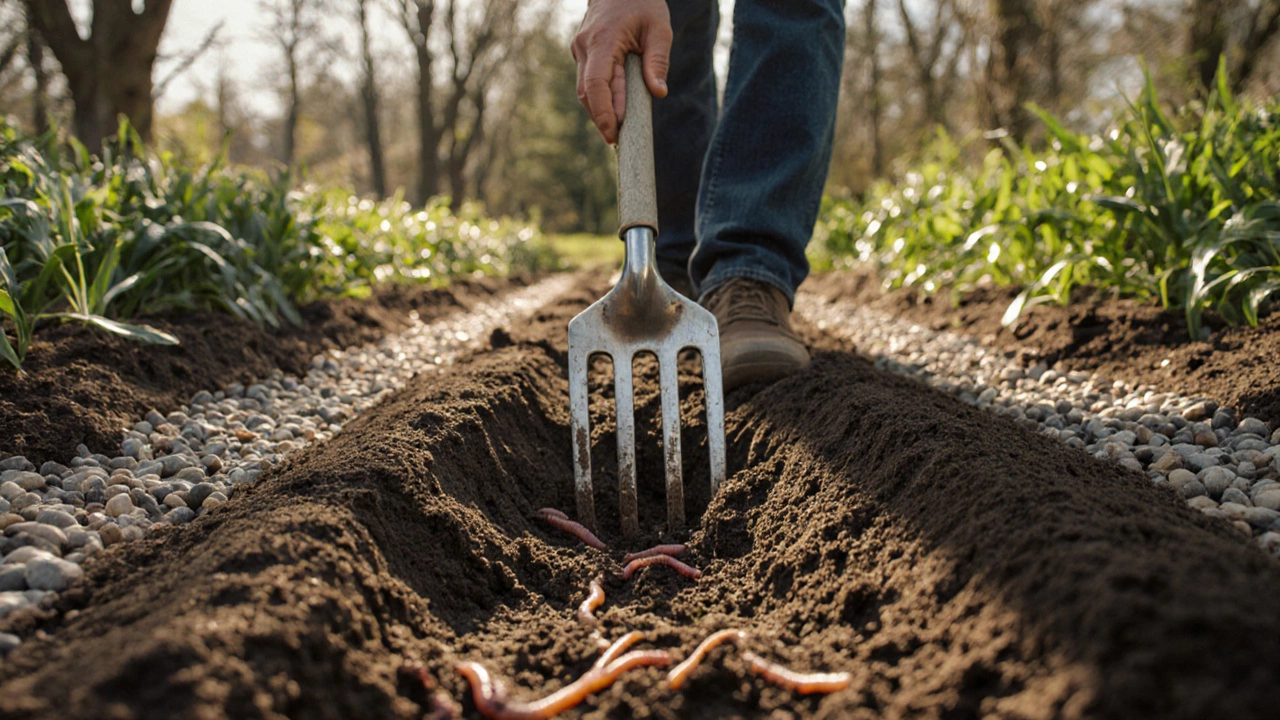Soil Compaction Assessment Tool
How is your garden soil performing?
Select all symptoms you observe in your garden:
Your Soil Analysis
If your garden soil feels like concrete after a light rain, or if your plants are stunted despite regular watering and feeding, you’re probably dealing with compacted soil. It’s one of the most common-but often overlooked-reasons gardens fail. Compacted soil doesn’t just make digging hard; it kills root growth, blocks water drainage, and suffocates the tiny organisms that keep soil alive. The good news? You can fix it. And you don’t need expensive tools or years of experience to do it.
Why Soil Gets Compacted
Soil compaction happens when the spaces between soil particles get crushed. This usually occurs from:- Walking or driving over garden beds
- Heavy rainfall on bare soil
- Using power tools like rototillers too often
- Clay-heavy soil that naturally sticks together
In Manchester, where rain is frequent and gardens are often small, compacted soil is especially common. People tend to step on borders while weeding, or leave paths bare between plants. Over time, the soil turns dense and hard-like a brick with no air holes.
Healthy soil should feel crumbly, not powdery or rock-hard. When you squeeze a handful, it should hold its shape briefly, then break apart easily. If it forms a tight ball that won’t crumble, it’s compacted.
Signs Your Soil Is Too Compacted
You don’t need a lab test to know your soil is in trouble. Look for these signs:- Water pools on the surface instead of soaking in
- Plants grow slowly, even with fertilizer
- Roots stay shallow and don’t spread
- Grass turns brown in patches despite watering
- Hard to push a garden fork or trowel into the ground
If you’ve tried adding compost and nothing changed, compaction is likely the hidden problem. It’s not a lack of nutrients-it’s a lack of space.
Step-by-Step: How to Fix Compacted Soil
Fixing compacted soil isn’t a one-time fix. It’s a process that takes patience and the right tools. Here’s how to do it right.1. Stop Walking on Garden Beds
The first step is to stop making the problem worse. Designate clear paths between beds using wood chips, gravel, or stepping stones. Never step into planting areas-even if you’re just reaching for a weed. Each footstep crushes air pockets deeper into the soil.2. Aerate the Soil
Aeration breaks up the hard layers without turning the soil over. For small areas, use a garden fork. Push it into the soil as deep as you can, then rock it back and forth to create small cracks. Do this every 6-12 inches across the bed. Don’t lift the soil-just open it up.For larger areas, a manual core aerator (like the Yard Butler or Redmax) pulls out small plugs of soil. Leave the plugs on the surface-they’ll break down and add organic matter back in. Avoid power aerators unless you have a big yard; they can damage roots and disturb beneficial fungi.
3. Add Organic Matter
Compacted soil needs air, water, and microbes. Organic matter gives all three. Spread 2-3 inches of well-rotted compost, leaf mold, or aged manure over the surface. Don’t dig it in yet. Let earthworms and rain do the work.Why not dig? Because digging again can recompact the soil. Let nature handle the mixing. Earthworms will pull the compost down, creating tunnels that improve drainage and aeration. In six months, you’ll see a dramatic difference.
4. Use Mulch Long-Term
After amending the soil, cover it with 2 inches of mulch-wood chips, straw, or shredded bark. Mulch prevents rain from pounding the surface, reduces evaporation, and slowly adds more organic material as it breaks down. Reapply mulch once a year, in spring or fall.Never use plastic sheeting or landscape fabric under mulch. They block air and water, making compaction worse.
5. Plant Cover Crops in Off-Seasons
If you’re not planting vegetables in winter, sow cover crops. In the UK, rye, clover, or vetch work well. Their roots grow deep and fibrous, naturally breaking up hardpan. When spring comes, cut them down and leave the tops as mulch. You’ll get better soil without lifting a spade.
What Not to Do
Many gardeners make mistakes that make compaction worse:- Don’t add sand to clay soil. Sand and clay mix to form concrete. It’s a myth that sand loosens clay-it doesn’t.
- Don’t over-till. Rototillers shred soil structure and kill beneficial fungi. Use them once, maybe twice, in your lifetime.
- Don’t rely on chemical fertilizers. They feed plants but starve the soil life that keeps it loose.
- Don’t wait until plants are dying. Fix soil before planting. Prevention is easier than cure.
How Long Does It Take to See Results?
You’ll notice water soaking in faster within weeks after aerating and mulching. Roots will start to spread deeper in 2-3 months. Full soil recovery-where it feels spongy and alive-takes 6 to 12 months. But you’ll see better plant growth almost immediately.One gardener in Salford told me her tomatoes went from stunted to bursting with fruit after just one season of compost and mulch. She stopped walking on her beds, started using a fork instead of a spade, and never looked back.

When to Call a Pro
If your soil is rock-hard even after 6 months of effort, you might have a hardpan layer-dense clay or compacted subsoil 6-12 inches down. This needs deeper intervention.Professional soil remediation uses deep tilling tools or subsoilers. In urban gardens, it’s rare to need this. But if you’ve tried everything and nothing works, contact a local soil specialist. They can test for pH, structure, and compaction depth. In Manchester, companies like GreenRoots Soil Solutions offer affordable soil audits.
Preventing Future Compaction
Once your soil is healthy, keep it that way:- Always use paths or stepping stones
- Keep soil covered with mulch or plants
- Add compost every fall
- Use raised beds if space allows
- Test soil every 2 years with a simple pH and texture kit
Compacted soil doesn’t come back overnight-but it doesn’t have to stay that way either. With consistent care, your garden will become a thriving, living ecosystem. Not just a patch of dirt.
Can I use sand to loosen compacted clay soil?
No. Adding sand to clay soil creates a concrete-like texture. Clay particles are tiny and stick together; sand particles are larger and don’t bind well with them. Instead of improving drainage, the mixture becomes harder and less porous. Always use organic matter like compost, leaf mold, or aged manure to break up clay soil.
How often should I aerate my garden soil?
Aerate once a year in early spring or autumn, especially if you have heavy clay soil or high foot traffic. For light, sandy soils, every 2-3 years is enough. If you’re adding compost and mulch regularly, you may only need to aerate every other year. Watch for signs like pooling water or slow plant growth to know when it’s time.
Is a rototiller good for fixing compacted soil?
Only as a last resort, and even then, use it sparingly. Rototillers chop up soil structure and kill the fungal networks that hold soil together. They can make compaction worse over time by breaking down aggregates into fine dust. Use a garden fork for gentle aeration instead. Reserve the rototiller for initial bed prep only, not for ongoing maintenance.
Can I fix compacted soil in a raised bed?
Yes, but it’s less likely to happen. Raised beds are designed to avoid compaction because you don’t walk on them. If your raised bed soil is hard, it’s probably because you’re using poor-quality topsoil or haven’t added enough compost. Mix in 2-3 inches of well-rotted manure or leaf mold annually, and top with mulch. That’s usually enough to keep it loose and healthy.
How do I know if my soil is still compacted after treatment?
Do the squeeze test. Grab a handful of moist soil and squeeze it. If it forms a tight ball that doesn’t crumble when you poke it, it’s still compacted. If it holds shape briefly, then breaks apart easily, it’s healthy. You can also try pushing a screwdriver into the ground-if it goes in with little resistance, your soil is improving. If it’s still hard to push in after 6 months, revisit your approach.

